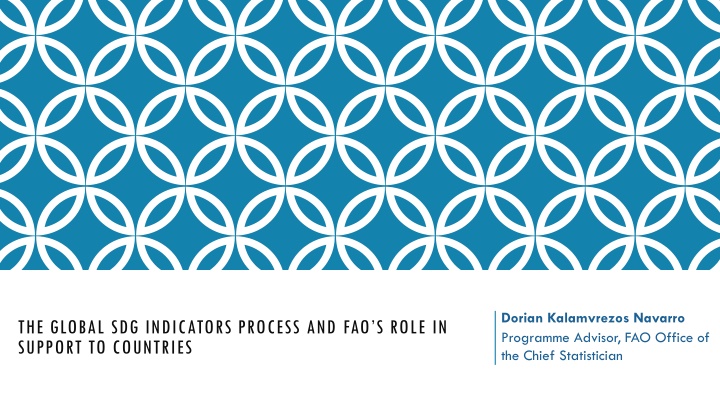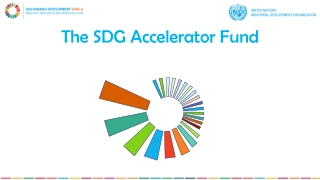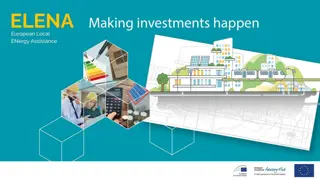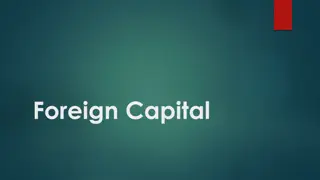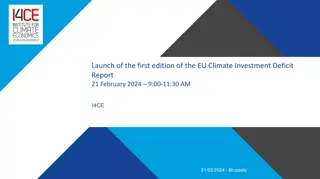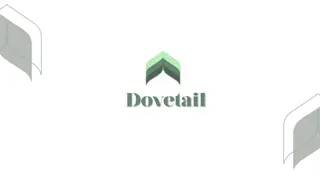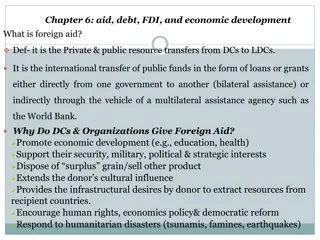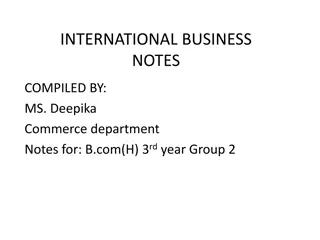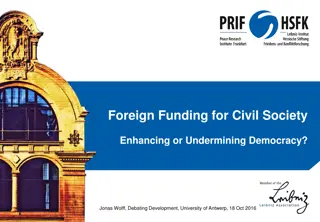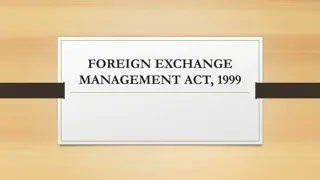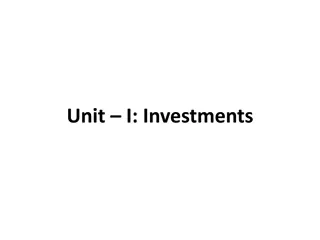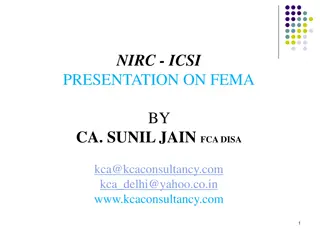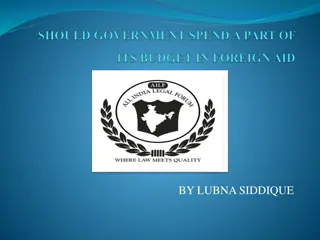Facilitating Foreign Investments for Sustainable Development
Facilitation of foreign investments plays a crucial role in promoting sustainable development worldwide. This involves addressing key issues like environmental protection, human rights, and regulatory coherence. New trends in investment agreements are focusing on promoting sustainable development through CSR obligations for investors and enhancing transparency commitments. The scope of agreements is limited to investments contributing to sustainability, with efforts to link environmental and social protection to international standards.
Download Presentation

Please find below an Image/Link to download the presentation.
The content on the website is provided AS IS for your information and personal use only. It may not be sold, licensed, or shared on other websites without obtaining consent from the author.If you encounter any issues during the download, it is possible that the publisher has removed the file from their server.
You are allowed to download the files provided on this website for personal or commercial use, subject to the condition that they are used lawfully. All files are the property of their respective owners.
The content on the website is provided AS IS for your information and personal use only. It may not be sold, licensed, or shared on other websites without obtaining consent from the author.
E N D
Presentation Transcript
Dorian Kalamvrezos Navarro Programme Advisor, FAO Office of the Chief Statistician THE GLOBAL SDG INDICATORS PROCESS AND FAO S ROLE IN SUPPORT TO COUNTRIES
THE GLOBAL SDG INDICATOR FRAMEWORK The 2030 Agenda for Sustainable Development will guide the actions of governments, international agencies, civil society and other institutions over the next 15 years UN Statistical Commission responsible for developing the SDG monitoring framework Inter-Agency Expert Group on SDG indicators (IAEG-SDG) to prepare an initial proposal and oversee this work through to 2030 28 countries as members, representing regions; International organizations only as observers
THE 48THUN STATISTICAL COMMISSION (MARCH 2017): Agreed with the refined global indicator framework (GIF) comprising 232 unique indicators; Agreed with the IAEG-SDG s proposed plan for annual refinements and for two comprehensive reviews of the indicators in 2020 and 2025; Urged the IAEG-SDG to accelerate the methodological development of Tier III indicators; Recognized the valuable role of custodian agencies in global reporting and recommended them to increase their capacity building and technical assistance efforts; The global indicator framework was adopted by ECOSOC (June 7th) and is expected to be endorsed by the UN General Assembly in September.
THE ROLE OF CUSTODIAN AGENCIES For each indicator a custodian agency has been identified responsible for: collecting data from national sources, ensuring their comparability and consistency, and disseminating them at global level further methodological development and documentation of the indicators statistical capacity development of countries to generate and disseminate national data contributing to monitor progress at the global, regional and national levels
MAIN DECISIONS TO DATE ON GLOBAL REPORTING Global versus national or thematic indicators Global indicators as a core set of metrics that all countries are invited to monitor (classified in three Tier according to methodological development and data availability) Global indicators can be complemented with national or thematic indicators (par. 75 of the UN resolution on the 2030 Agenda) Global reporting mechanism International organizations responsible for collecting national data, harmonizing them, aggregating them at regional and global level and transmitting them to the IAEG-SDG Secretariat Global monitoring is based on data produced by countries, with NSOs having a key coordinating role at national level. If estimates produced by international organizations, prior consultation with countries before publication
THE 5THIAEG-SDG (MARCH 2017): Encouraged custodian agencies to accelerate the work on Tier III indicators Approved the upgrade of four out of eleven Tier III indicators that applied to move to the Tier II category, thus enabling global reporting to begin. For FAO, approved the upgrade of two Tier III indicators: the indicator of food price anomalies (2.c.1) and of women s access to land (5.a.1). Advised on the timeline for Tier category upgrades (autumn 2017-2018) Presented new criteria for upgrading Tier III indicators: regionally representative pilot testing; information on NSOs involvement; draft metadata; information on governing bodies approval of new international standards;
STATUS OF SDG INDICATORS UNDER FAO CUSTODIANSHIP AS OF APRIL 2017 FAO as custodian agency (21 indicators) Goal Indicators Goal 2 (Food security, Nutrition, Sustainable Agriculture) 2.1.1 2.1.2 2.3.1 2.3.2 2.4.1 2.5.1 2.5.2 2.a.1 2.c.1 Goal 5 (Gender equality) 5.a.1 5.a.2 TIER LEVEL OF DEVELOPMENT Goal 6 (Use of Water) Goal 12 (Sustainable Consumption and Production) 6.4.1 6.4.2 Established methodology exists and data already widely available I Methodology established but data not easily available (>50% country coverage) II 12.3.1 Goal 14 (Oceans) 14.4.1 14.6.1 14.7.1 14.b.1 Internationally agreed methodology not yet developed, data largely unavailable III Goal 15 (Life on Land) 15.1.1 15.2.1 15.4.2
FAO KEY IMMEDIATE PRIORITIES: Accelerate the work on Tier III indicator in order to upgrade all the remaining indicators (8) at the next IAEG-SDG session in October 2017. Intensify statistical capacity development support across all 21 SDG indicators. Advise countries on aligning their national monitoring framework to the SDG indicators and assisting in data gap analyses.
FAOS WORK ON SDG INDICATOR METHODOLOGIES In some cases, no internationally agreed operational definition, for example: Definition of small-scale producer (indicators 2.3.1 and 2.3.2) Definition of agricultural sustainability (indicators 2.4.1) Definition of rural/urban areas (most SDG indicators) In other cases, an internationally agreed methodology, has not yet been developed (e.g. indicators 5.a.2, 12.3.1) In response, FAO is developing new methodological proposals and survey tools, and is also organizing expert meetings, pilot tests, and country consultations
FAO CAPACITY DEVELOPMENT STRATEGY FOR SDG REPORTING Enlarge the pool of SDG monitoring experts Catalytic fund established at FAO to support capacity development efforts though E-learning courses, Training of Trainers & Regional workshops New web portal on FAO-related SDG indicators for communication & data dissemination Support to national data collections Producing new survey/tools as global public goods Partnering with other IOs to add short modules to internationally-led surveys and streamline data reporting Use of new cost-effective methods and new data sources (e.g. remote sensing)
EXAMPLE OF CAPACITY DEVELOPMENT SDG INDICATOR 2.1.2 PREVALENCE OF MODERATE OR SEVERE FOOD INSECURITY IN THE POPULATION BASED ON THE FOOD INSECURITY EXPERIENCE SCALE (FIES) The Food Insecurity Experience Scale FIES is: A measure of food access at the individual or household level based on direct interviews with people Distinguishes moderate and severe levels of food insecurity: Indicator valid also for developed countries Complements FAO s Prevalence of Undernourishment indicator Simple to apply at low cost easily included in national surveys Produces timely, reliable and actionable information: useful for early warning and long-term policy measures
COUNTRYS SUPPORT ON THE FIES Tools (language translations/adaptation, software for data processing) Advocacy to explain the added value (policy relevance) of adopting the FIES to national decision makers Organization of training workshops at regional, sub-regional & country-level Technical assistance (remote and on-site) to: Help include the FIES survey module in national surveys Conduct data analysis and produce FS monitoring reports Plans to place technical advisers in regional offices and promote south-south technical cooperation
COUNTRYS IMPLEMENTATION OF THE FIES Using a similar tool: Brazil, Canada, Colombia, Ecuador, Guatemala, Israel, Mexico and USA FIES already included in national surveys: Burkina Faso, Cameroon, Kenya, Malawi, Mauritania, Swaziland, Rwanda, the Seychelles, Pakistan, Indonesia, St. Lucia, El Salvador, the Dominican Republic, Marshall Islands FIES to be adopted in the near future: Laos, the Philippines, Palestine Territories, Jordan, North Sudan, Dem. Rep. Congo, Zanzibar, Morocco, Spain, Nicaragua, Kiribati, Samoa, UEMOA countries. Partners engaged in implementing the FIES: World Bank (LSMS, GAFSP), GIZ, USAID, IPC, WFP, UEMOA, ESCWA, CILSS, SESRIC,
CONCLUSION: THE IMPORTANCE OF ALIGNING NATIONAL AND GLOBAL MONITORING FRAMEWORKS 1) Alignment of national and global indicator frameworks in the best interest of countries 2) Commitment of countries to monitoring global indicators in addition to national indicators (par. 75 of the UN resolution on the 2030 Agenda) 3) Coordinating / quality assurance role of NSOs at country level 4) Coordinating / quality assurance role of custodian agencies at global level
